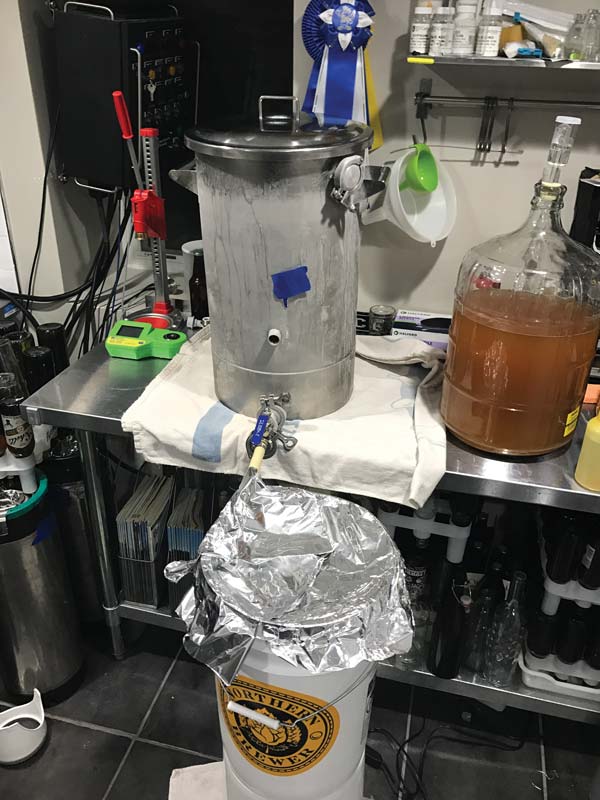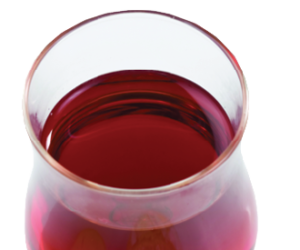It can be some of the most expensive and sought-after wine in the world. Ice wine production can be extremely labor-intensive with some commercial production selectivity going down to selecting the fruit one berry at a time. But home winemakers aren’t constrained like commercial producers. Here, we’ll take a spin through the many ways ice wines and ciders can be produced at home.
Commercial Ice Wine Production
Authentic commercial ice wine is a rare, delicious, and tightly regulated beverage. Canada’s Ontario province is the world’s largest producer. Germany, where it is called Eiswein, also has a long history with this high-acid, very sweet dessert wine. Common to those sources and others, like U.S. states Michigan, New York, and Oregon, are requirements that grapes are naturally frozen on the vines. Regulations go further: The grapes must be harvested while frozen and pressed without thawing. Harvest proceeds quickly in ambient temperatures of about 18 °F (-8 °C) and grapes are rushed to the winery. By the time the weather reaches the right conditions, the grapes have also been hanging on the vines long enough that sugar levels are elevated.
While water freezes solid in the grapes, a sugar syrup forms that also concentrates the natural acids. That syrupy juice is pressed out of the frozen grapes, leading to a must of about 40 °Brix and a total acidity (TA) of about 10 g/L. A long, cool fermentation follows. With a combination of chilling, sulfite addition, and sterile filtration, the fermentation is stopped with a residual sugar of 10–20%. White grapes, including Riesling and hybrids like Vidal Blanc, are commonly used, but Pinot Noir, Cabernet Franc, and other reds also are employed. Aromas of apricot, honey, peach, and pear highlight sweet flavors. Pairings are most common with creamy desserts, but the wines may also go well with strong cheeses or meats like foie gras.
As always, though, home winemakers can do what we want and results count more than regulations!
Because of the stringent requirements for on-the-vine freezing and frozen pressing, it is unlikely many home winemakers can duplicate the commercial process. As always, though, home winemakers can do what we want and results count more than regulations! Ice-style wine, if you will, is definitely within reach if you want to try making one of these high-acid, high-sugar dessert wines for yourself.
Ice Cider Production
Ice cider is a similar beverage with strict regulations for the commercial product. Because ripe apples tend to fall from the trees, they don’t have to be frozen in place. Rather, they are harvested, kept cool in bins, then set outside to freeze once the weather is cold enough. They are brought back inside the winery, allowed to partially thaw, and then are pressed without crushing.
While some home cidermakers might be able to do that with a bladder press, once again the result is of more interest than the regulations. Fortunately, since colonial times home apple growers have been using cold weather to “jack” cider in making apple jack, a higher-alcohol drink like ice cider. Most modern apple jack is distilled with heat just like other spirits, but jacking, sometimes called cryo-distilling, is within home cidermakers’ reach.
Homemade Ice Wine
So rather than dwell on the commercial methods, specific weather, and heavy equipment needed for the “real thing,” we will look at the steps you can take at home to make ice-style wine or apple jack for your own enjoyment. (In Canada, it is usually spelled “icewine” and in the U.S. as two words “ice wine.” I’ll just call our home version “ice wine” with the -style implied.)
Once you have a high-sugar, high-acid juice or must that resembles the syrupy press yield from frozen grapes or partially thawed apples, the fermentation process will be the same. I’ll discuss that first, then offer some methods for getting such a must. Since the high sugar level is challenging for the yeast and fermentation is done at a cool temperature, expect it to take longer than conventional wine or cider. Pour or rack your prepared must into a carboy fitted with an airlock.
For most people, three gallons (11 L) will be enough of this sweet dessert wine to last a while, so a 5-gal. (19-L) carboy works well as a primary fermenter that allows headspace for foaming. Start with the must at warm room temperature, around 75 °F (24 °C). Measure the Brix level. Since many refractometers and hydrometers only go up to 32 °Brix, you may need to dilute a sample 50:50 with distilled water, then double the reading. This is not precisely correct because Brix is percent sugar by weight rather than volume, but it is close enough for this project.

Use twice as much yeast as you would with ordinary juice; 2 g of yeast per gallon (3.8 L). Use rehydration nutrients to get a healthy ferment. Heat 70 mL of clean, chlorine-free water to 104 °F (40 °C). Stir in 7 g of Go-Ferm Protect Evolution™ from Lallemand or similar yeast rehydration nutrient. Allow to stand 10 minutes, stir again, and stir in 6 g of a robust yeast like Uvaferm 43 or Red Star Premier Blanc. Let stand another 10 minutes and check the temperature. You want a temperature difference of less than 15 °F (8 °C) between the yeast slurry and the must. If your difference is greater than that, add 35 mL of must to the slurry, stir, wait 10 minutes and check again. Repeat the must addition if needed, then stir the tempered yeast slurry into the must.
Fit a fermentation lock to the carboy and move it to a cool cellar, around 55 °F (13 °C). Monitor the drop in Brix every day, using a sanitized thief, hydrometer, and hydrometer jar so you can return the sample to the fermentation. When you are within 2 or 3 °Brix of your target final sugar level, stop the fermentation. Rack the wine into a PET carboy or a stainless-steel keg and place that vessel in a larger bucket. Fill the bucket with ice up to the neck of the PET carboy or top of the keg. Add 50 mg/L of sulfite to the juice. Replenish the ice as needed to keep the wine cold.
After three days, rack again to a topped-up carboy and add another 50 mg/L of sulfite. Fit an airlock and watch for signs of refermentation. If you see bubbles, add another 50 mg/L of sulfite. Age two or three months and fine with bentonite if the wine does not clear. When it is stable, add potassium sorbate at a rate of ½ tsp. per gallon (0.66 mL/L). Filter your ice wine or cider through a nominal sterile filter (using coarser prefilters if needed), add a final 10 mg/L of sulfite, and bottle in 375-mL half-bottles.
Kits and Concentrates
Now to get that must. If you want a wine with 10 or 11% ABV and residual sugar of around 15% (150 g/L), you will need a starting must about 35 °Brix. The simplest approach is to buy an ice wine-style kit such as Winexpert’s Après Riesling Icewine Style or RJS Craft Winemaking’s Cru Specialty Vidal Dessert Wine. If you do that, disregard my winemaking instructions from earlier and follow the kit instructions exactly.
The next easiest approach is to use packaged grape concentrate. These natural grape syrups are produced using vacuum distillation of grape juice and usually finish with a sugar content of 68 °Brix. Diluted 50:50 with distilled water, you will get a must in the range for ice wine. Start by adding a bit less water, check the Brix, and continue to dilute until your starting target is achieved.
Frozen Juice
Commercial frozen white grape juice can also be used for this project. When you receive your pail of frozen juice, place it in a cool location and allow it to begin thawing. From time to time, pour off the syrup that will thaw first into your carboy. When you are approaching a volume of about half what you started with, measure the Brix of your must. If it is too high, continue adding melted juice until you reach your target.
You can apply the reverse process to your own or purchased fresh juice. Place the juice in a plastic bucket, put on the lid, and put the bucket in a chest freezer. Check every few hours and use a stainless steel mesh strainer to strain out ice crystals as they form. Keep these in another bucket in case you want to add some back if you overshoot your Brix target in the remaining must. Warm the resulting must to room temperature and proceed as described earlier.
Cider Methods
Now that you are relaxing and enjoying your ice wine, what about ice cider and apple jack? Ice cider is a relatively new commercial product, developed primarily in Quebec in the 1990s. Apple jack made with natural freezing dates back to at least colonial times. Ice cider resembles ice wine in that it involves fermenting a pre-concentrated juice. The favored method is to allow apples to naturally freeze, either on the trees or in bins after harvest, and then thaw. You can do this at home with either natural or mechanical freezing if you have a bladder press that will press partially frozen fruit.
Freeze crates of apples, then place them in a cool room to partially thaw. Stir the apples from time to time to assure that they thaw evenly. When soft enough to yield to the pressure of your thumb, load the press and collect the juice. Measure Brix as for ice wine and follow the fermentation method described earlier. Quebec commercial requirements stipulate a starting Brix of at least 30 and residual sugar above 130 g/L, but as a home cidermaker you can view these as guidelines rather than rules. Squeezing previously frozen apples is called cryo-extraction.
Cryo-concentration is the alternative approach to ice cider. Crush the apples and press in the usual manner, then freeze the juice. After it is frozen, allow to partially thaw and drain off the concentrated juice. At home you can put a bucket of juice in a freezer as described earlier for ice wine. You can either periodically strain out ice with a stainless mesh strainer or freeze completely and collect the syrupy juice as it thaws.
Apple jack, on the other hand, is concentrated after fermentation. While the modern commercial product is generally produced by thermal distillation and is closely related to apple brandy, the colonial recipe used freezing. Although sometimes called cryo-distillation, there is really no distillation involved as there is no evaporation — just freezing. Make your cider in the usual manner, preferably with some residual sweetness. Then, either outdoors or in a freezer, freeze the cider.
You may use either of the concentration techniques previously noted—strain out ice crystals or freeze and drain off concentrated cider. Removing ice from a barrel of cider left out to freeze overnight was the original “jacking” of colonial times. Alcohol, sugar, and malic acid will all be concentrated in the part that freezes last or thaws first. Stabilize and clarify, then bottle in 375-mL half-bottles.
Once you have both ice wine and either ice cider or apple jack, plan how you will showcase them to friends and family. These beverages are best enjoyed chilled and usually in small glasses. Pair with a rich creamy dessert like crème brûlée or Bavarian cream, or step over to the savory side with pâté or foie gras.






